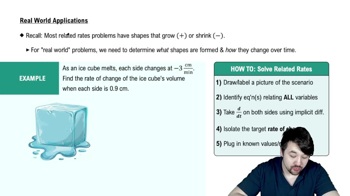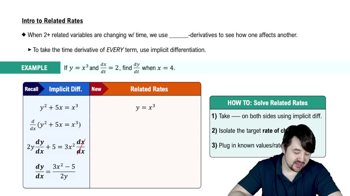Table of contents
- 0. Functions7h 52m
- Introduction to Functions16m
- Piecewise Functions10m
- Properties of Functions9m
- Common Functions1h 8m
- Transformations5m
- Combining Functions27m
- Exponent rules32m
- Exponential Functions28m
- Logarithmic Functions24m
- Properties of Logarithms34m
- Exponential & Logarithmic Equations35m
- Introduction to Trigonometric Functions38m
- Graphs of Trigonometric Functions44m
- Trigonometric Identities47m
- Inverse Trigonometric Functions48m
- 1. Limits and Continuity2h 2m
- 2. Intro to Derivatives1h 33m
- 3. Techniques of Differentiation3h 18m
- 4. Applications of Derivatives2h 38m
- 5. Graphical Applications of Derivatives6h 2m
- 6. Derivatives of Inverse, Exponential, & Logarithmic Functions2h 37m
- 7. Antiderivatives & Indefinite Integrals1h 26m
- 8. Definite Integrals3h 25m
4. Applications of Derivatives
Related Rates
Problem 54
Textbook Question
Robert Boyle (1627–1691) found that for a given quantity of gas at a constant temperature, the pressure P (in kPa) and volume V of the gas (in m³) are accurately approximated by the equation V=k/P, where k>0 is constant. Suppose the volume of an expanding gas is increasing at a rate of 0.15 m³/min when the volume V=0.5 m³ and the pressure is P=50 kPa. At what rate is pressure changing at this moment?
 Verified step by step guidance
Verified step by step guidance1
Identify the relationship between volume V and pressure P given by the equation V = k/P, and differentiate both sides with respect to time t to find the relationship between the rates of change of volume and pressure.
Use implicit differentiation on the equation V = k/P to obtain dV/dt = -k/P^2 * dP/dt, where dV/dt is the rate of change of volume and dP/dt is the rate of change of pressure.
Substitute the known values into the differentiated equation: dV/dt = 0.15 m³/min, V = 0.5 m³, and P = 50 kPa to find the value of k using the original equation V = k/P.
Calculate the constant k using the values of V and P: k = V * P.
Finally, solve for dP/dt by rearranging the differentiated equation and substituting the values of dV/dt, k, and P.
Recommended similar problem, with video answer:
 Verified Solution
Verified SolutionThis video solution was recommended by our tutors as helpful for the problem above
Video duration:
3mPlay a video:
Was this helpful?
Related Videos
Related Practice






